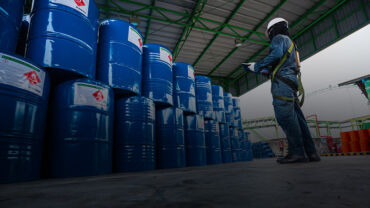The past few years have been extraordinarily challenging for the professionals who oversee supply chains at multinational corporations. They have managed an unprecedented series of disruptions that imperiled international commerce, threatened companies’ survival, and elevated global trade management to a top concern for the C-suite and corporate directors.
The list of disruptions is long: the US-China tariff war, Brexit, the COVID-19 pandemic, and evolving international trade deals including the United States-Mexico-Canada Agreement and the Trans-Pacific Partnership.
And the stakes could hardly be higher. Cross-border trade comprises nearly half of the global GDP and undergirds mission-critical corporate functions including product development, procurement, manufacturing, sales, and distribution.
“In the aftermath of the first COVID-19 wave, many firms found themselves either fighting for survival or realizing the importance of increasing their [supply chain] resilience to reduce the costs they will incur during the next disruption,” said Jeremie Gallien of the London Business School.
The next disruption. How can companies best prepare for it?
_______________________________________________________
Avoid supply chain disruption with analytics
A new special report from Thomson Reuters and SupplyChainBrain, Avoiding Supply Chain Disruption with Analytics and Proactive Global Trade Planning, explores how new technology solutions enable companies to automate processes, gain visibility into their entire supply chain, deftly manage the movement of goods, and generate actionable intelligence and strategic insights.
_______________________________________________________
The special report delves into three key areas.
Data is the key to managing trade compliance and supply chain risk
“Complete, up-to-date knowledge of commodity classifications, duty schedules, quotas, country-of-origin rules, inspection regimes, and free trade agreements (FTAs) is widely understood to be essential in defensively managing compliance risk, from sourcing to final sale,” the report noted. This data also can inform decisions and activities across critical corporate functions.
Global trade analytics add value to the business
A recent report from Bain & Company said advanced analytics can improve supply forecast accuracy by 20% to 60%, and Euler Hermes reported that “highly digitized” companies take more steps to mitigate supply chain disruptions. “Forty-seven percent mentioned they were improving their understanding of their supply chains,” the trade credit insurer wrote. “And 39% reported increasing due diligence on suppliers (vs. 33% and 14% of the least digitized ones, respectively).”
The special report from Thomson Reuters and SupplyChainBrain notes that the addition of advanced analytics has made global trade management software a more valuable tool for:
- Sourcing and routing decisions that raise overall productivity, shorten procure-to-pay cycles, and lower the total landed cost of finished products
- Calculating trade-related costs, including port demurrage fees and other third-party fees, so sourcing can be factored into product design and development as well as supplier selection
- Standardizing and storing customer and supplier data and electronically filing documents in order to avoid border-crossing delays
- Automating high-volume, repetitive trade compliance tasks to reduce errors, speed processing, shorten lead times in receiving goods for shipment, and free up staff for more complex problems and higher-value work
“The use of global trade management software opens a window into the supply chain that generates important data and insights about broader operations,” said Suzanne Offerman, senior proposition manager for ONESOURCE Global Trade at Thomson Reuters. “You’re tracking the provenance of goods, running cost and risk analyses, weighing strategic options, and measuring supply chain performance. The objective is the same for compliance and for planning and design—to monitor operations in real time and tease out patterns from the data that identify new opportunities or areas for improvement.”
Brexit’s impact on the supply chain is a top priority for multinationals and trade compliance teams
The UK’s separation from the European Union provided companies with much-needed certainty—but post-Brexit challenges and concerns remain regarding the potential for border disputes, supply chain disruptions, shipping delays, increased import and export costs, and new and evolving free trade agreements (FTAs).
“The EU is telling its exporters that they need to classify their goods and then develop origin determination, calculation, certification, and record-keeping processes,” the report noted. “Importers need to make sure that exporting suppliers provide the necessary evidence of origin qualification, understand how to claim preference at import, and instruct customs brokers in keeping records. . . . Contentious issues around fisheries and cooperative development of offshore wind power generation—requiring cross-border construction and maintenance, third-country imports of equipment and components, and shared grid connections—may be technically resolved, but have become far more complicated in terms of global trade management.”
The report says challenges are likely to emerge in the interplay between multilateral and bilateral FTAs, particularly for industries, such as automotive, that have complex cross-border sourcing requirements. For example, a car plant assembling a vehicle may have multiple suppliers in multiple countries for each of the thousands of parts they use—which could be covered under one FTA or bilateral agreement but not another. Assessing cost impacts and alternative Brexit supply chain strategies will entail highly detailed, data-dependent decisions.
How trade compliance teams can deliver strategic value with global trade technology solutions
Advanced analytics that deliver real-time visibility into the supply chain from end-to-end and automate processes to keep goods moving are fast becoming the industry standard.
In addition, the trade compliance data that these AI-enabled platforms generate has value far beyond risk management. It can provide unique insights into company operations and partner networks that can improve efficiency, resiliency, and customer experience. In this way, trade compliance teams are able to provide their companies with strategic value and long-term competitive advantage.
Download the special report, Avoiding Supply Chain Disruption with Analytics and Proactive Global Trade Planning, to learn more.






